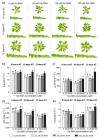Exploring the Potential of Selenium-Containing Amine (Se-AMA) to Enhance Photosynthesis and Leaf Water Content: New Avenues for Carbonic Anhydrase Modulation in Arabidopsis thaliana
- PMID: 39861611
- PMCID: PMC11768400
- DOI: 10.3390/plants14020258
Exploring the Potential of Selenium-Containing Amine (Se-AMA) to Enhance Photosynthesis and Leaf Water Content: New Avenues for Carbonic Anhydrase Modulation in Arabidopsis thaliana
Abstract
Global changes and growing demands have led to the development of new molecular approaches to improve crop physiological performances. Carbonic anhydrase (CA) enzymes, ubiquitous across various life kingdoms, stand out for their critical roles in plant photosynthesis and water relations. We hypothesize that the modulators of human CAs could affect plant physiology. Our research demonstrated that foliar treatments with a synthetic selenium-containing CA activator (Se-AMA) influenced the physiological performances of Arabidopsis thaliana. Se-AMA increased net photosynthesis (A + 31.7%) and stomatal conductance (gs + 48.2%) at 100 µM, with the most notable effects after 10 days of treatment. Se-AMA at 300 µM proved to be even more effective, boosting A and gs by 19.9% and 55.3%, respectively, already after 3 days of application. Morning treatment with Se-AMA at 300 µM enhanced photosynthetic performances throughout the day, suggesting that the positive effect of Se-AMA lasted for several hours. Additionally, Se-AMA increased water content in plants by 17.1%, suggesting that Se-AMA treatment may have improved plant water absorption and resource management. This effect might be linked to Se-AMA's role in modulating specific CA isoforms working with aquaporins. Although preliminary, these findings suggest that Se-AMA could enhance plant physiological performances under the conditions of non-limiting water availability.
Keywords: apparent carboxylation efficiency; leaf gas exchange; net photosynthesis; stomatal conductance; synthetic activators.
Conflict of interest statement
The authors declare no conflict of interest.
Figures






Similar articles
-
Regulation of photosynthesis and stomatal and mesophyll conductance under water stress and recovery in olive trees: correlation with gene expression of carbonic anhydrase and aquaporins.J Exp Bot. 2014 Jul;65(12):3143-56. doi: 10.1093/jxb/eru160. Epub 2014 May 5. J Exp Bot. 2014. PMID: 24799563 Free PMC article.
-
Overexpression of cytoplasmic C4 Flaveria bidentis carbonic anhydrase in C3 Arabidopsis thaliana increases amino acids, photosynthetic potential, and biomass.Plant Biotechnol J. 2022 Aug;20(8):1518-1532. doi: 10.1111/pbi.13830. Epub 2022 Jun 12. Plant Biotechnol J. 2022. PMID: 35467074 Free PMC article.
-
The response of foliar gas exchange to exogenously applied ethylene.Plant Physiol. 1986 Nov;82(3):653-7. doi: 10.1104/pp.82.3.653. Plant Physiol. 1986. PMID: 16665086 Free PMC article.
-
Emerging roles for carbonic anhydrase in mesophyll conductance and photosynthesis.Plant J. 2020 Feb;101(4):831-844. doi: 10.1111/tpj.14638. Epub 2020 Jan 6. Plant J. 2020. PMID: 31816145 Review.
-
Regulation of photosynthesis of C3 plants in response to progressive drought: stomatal conductance as a reference parameter.Ann Bot. 2002 Jun;89 Spec No(7):895-905. doi: 10.1093/aob/mcf079. Ann Bot. 2002. PMID: 12102515 Free PMC article. Review.
References
LinkOut - more resources
Full Text Sources

